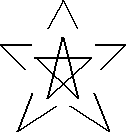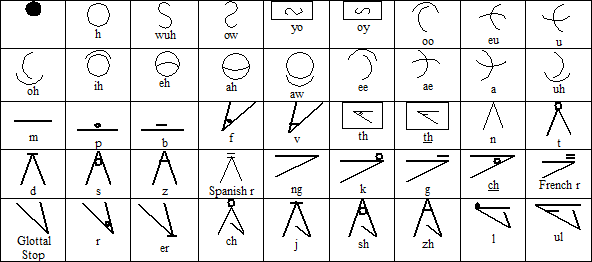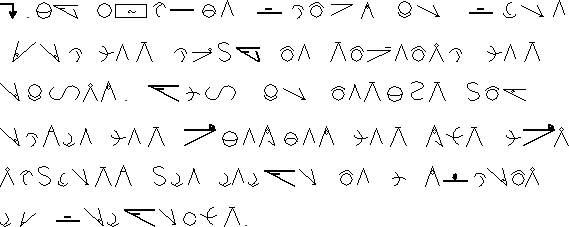Pictosounds were created by Jerry Prince to be the alphabet for an international auxiliary language he is currently working on. Any feedback would be appreciated.
The Pictosounds are images based on the position of the mouth and tongue when saying the letter. It should be easy to learn the entire alphabet by understanding what the shape of each letter represents.
The Pictosounds are divided into two main categories: Blocked Sounds
and Unblocked Sounds. Blocked sounds are sounds made by creating a
blockage to the free flow of air through the mouth or throat. The blocked sounds are
 roughly equivalent to the consonants. The unblocked sounds are roughly equivalent to
the vowels.
roughly equivalent to the consonants. The unblocked sounds are roughly equivalent to
the vowels.
There are 27 blocked and 18 unblocked picto-sounds, making an alphabet of 45 pictosounds. All of the pictosound shapes are derived from the familiar image on the right:
The pictosounds all begin from three fundamental images:
 A blocked sound is a sound created by blocking the free flow of air through
the throat. Blocked sounds therefore give a physical form to a sound. This is
what a human being does with words. The human being is represented by the star
of the Logos symbol.
A blocked sound is a sound created by blocking the free flow of air through
the throat. Blocked sounds therefore give a physical form to a sound. This is
what a human being does with words. The human being is represented by the star
of the Logos symbol.
All of the 27 blocked pictosounds are shapes derived from the star inside the circle:
There are eight families of related sounds that do not require any movement of the tongue to go from one to another in the group. Unrelated sounds require moving the tongue to a different position. The eight families of sound blocks are used to produce sound by using the following six different methods:
The chart below provides a brief description of all the 27 blocked sounds (with IPA symbol and an American English word for clarification):

*The glottal stop is not actually a nasal sound. It is a sudden silence caused by using the back of the tongue to block all sound from escaping the throat. The difference between the l's and r's is a matter of whether sound is part of the pronunciation or not.
 An Unblocked sound is created without creating an obstruction to the free flow
of air through the throat. Unblocked vocalization provides the vital energy of words.
This is the free expression of spirit that encompasses and gives meaning to a word.
With freewill, clear thinking gives meaning to a human being's life. This ideal of
clear thinking is represented by the halo (circle) of the Logos symbol.
An Unblocked sound is created without creating an obstruction to the free flow
of air through the throat. Unblocked vocalization provides the vital energy of words.
This is the free expression of spirit that encompasses and gives meaning to a word.
With freewill, clear thinking gives meaning to a human being's life. This ideal of
clear thinking is represented by the halo (circle) of the Logos symbol.
All of the 18 unblocked pictosounds are derived from this halo around the star:
Unblocked sound is created by changing the size of the opening the air must escape through and the exertion of the vocal chords. The unblocked pictosounds focus on two methods of controlling sound: pursing the lips and changing the height of the tongue.
There are three lip positions depicted by vertical images:

There are two tongue positions depicted by horizontal images:
The first unblocked sound is the condensed essence of the halo, ![]() .
It represents silence.
.
It represents silence.
The second unblocked sound is the halo itself, ![]() .
It is the "h" sound in the word Holy.
.
It is the "h" sound in the word Holy.
The next four unblocked sounds are actually not single sounds, but instructions to move the mouth and blend several sounds together (a glissando in musical terms):

These four vowels above are affected by the vowels surrounding them. If a vowel immediately precedes them, they start with that vowel's sound. If a vowel immediately follows, they end with that vowel's sound. Without a preceding or ending vowel, the sound quickly crosses the vowel chart below in a diagonal manner.
The remaining twelve vowels are shown in the chart below (with IPA symbol and sample word):

*The words quoted above are common English sounds that might be helpful in memorizing the chart of unblocked sounds.
The names of the letters are the sounds themselves.

Pictosounds are meant to be used phonetically. There is only one symbol per sound.
There are no upper and lower case letters or different forms of letters based on their position in a word or sentence. The orientation of the pictosound images should not be changed, i.e. the mouth image should always face left (or forward) to avoid the extra cognitive effort to decipher mirror or rotated images of the pictosounds.
However, the direction of writing can be whatever is most comfortable for the writer. An arrow at the beginning of the page should indicate the direction of writing, i.e. left to right and then down or top to bottom and then left. For example,
![]() would mean read left to right and then return to read the next line below.
would mean read left to right and then return to read the next line below.
![]() would mean read left to right and then turn and read the line below right to left.
would mean read left to right and then turn and read the line below right to left.
Similar arrow indicators should be used for other directions, like top to bottom and right to left writing.
It is possible to use the pictosounds to approximate the sounds of most words in most languages. Below is a sample transliteration of the English rendition of Article 1 of the Universal Declaration of Human Rights.

All human beings are born free and equal in dignity and rights. They are endowed with reason and conscience and should act towards one another in a spirit of brotherhood.
If you have any comments on Pictosounds, you can contact Jerry at: jkhalilprince@yahoo.com
Constructed scripts for: Ainu | Arabic | Chinese languages | Dutch | English | Hawaiian | Hungarian | Japanese | Korean | Lingala | Malay & Indonesian | Persian | Tagalog / Filipino | Russian | Sanskrit | Spanish | Taino | Turkish | Vietnamese | Welsh | Other natural languages | Colour-based scripts | Tactile scripts | Phonetic/universal scripts | Constructed scripts for constructed languages | Adaptations of existing alphabets | Fictional alphabets | Magical alphabets | A-Z index | How to submit a constructed script
[top]
You can support this site by Buying Me A Coffee, and if you like what you see on this page, you can use the buttons below to share it with people you know.

If you like this site and find it useful, you can support it by making a donation via PayPal or Patreon, or by contributing in other ways. Omniglot is how I make my living.
Note: all links on this site to Amazon.com, Amazon.co.uk
and Amazon.fr
are affiliate links. This means I earn a commission if you click on any of them and buy something. So by clicking on these links you can help to support this site.
[top]